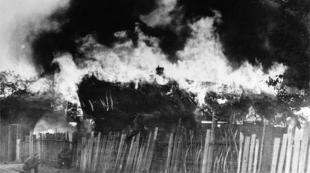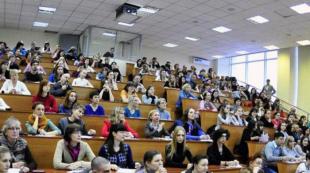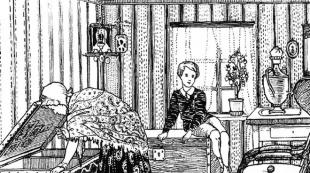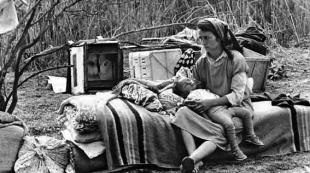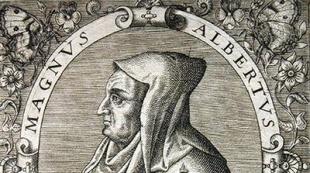Struggle by foreign conquerors in the 13th century. Lecture: The struggle of Russia against foreign invaders in the XIII century. Grand Duchy of Lithuania and Russia
The XIII century in the history of Russia is the time of armed opposition to the onslaught from the east (Mongol-Tatars) and the north-west (Germans, Swedes, Danes).
Mongol-Tatars came to Russia from the depths of Central Asia. The empire formed in 1206, headed by Khan Temuchin, who took the title of Khan of all Mongols (Genghis Khan), by the 30s. 13th century subjugated northern China, Korea, Central Asia, Transcaucasia. In 1223, in the Battle of Kalka, the combined army of Russians and Polovtsy was defeated by a 30,000-strong Mongols detachment. Genghis Khan refused to advance to the southern Russian steppes. Russia received an almost fifteen-year respite, but could not take advantage of it: all attempts to unite, stop civil strife were in vain.
In 1236, the grandson of Genghis Khan, Baty, began a campaign against Russia. Having conquered the Volga Bulgaria, in January 1237 he invaded the Ryazan principality, ruined it and moved on to Vladimir. The city, despite fierce resistance, fell, and on March 4, 1238, the Grand Duke of Vladimir Yuri Vsevolodovich was killed in the battle on the Sit River. Having taken Torzhok, the Mongols could go to Novgorod, but the spring thaw and heavy losses forced them to return to the Polovtsian steppes. This movement to the southeast is sometimes called the "Tatar raid": along the way, Batu plundered and burned Russian cities, which courageously fought against the invaders. Especially fierce was the resistance of the inhabitants of Kozelsk, nicknamed by the enemies of the "evil city". In 1238-1239. Mongol-Tatars conquered Murom, Pereyaslav, Chernigov principalities.
North-Eastern Russia was devastated. Batu turned south. The heroic resistance of the inhabitants of Kiev was broken in December 1240. In 1241, the Galicia-Volyn principality fell. The Mongolian hordes invaded Poland, Hungary, the Czech Republic, went to Northern Italy and Germany, but, exhausted by the desperate resistance of the Russian troops, deprived of reinforcements, retreated and returned to the steppes of the Lower Volga region. Here, in 1243, the state of the Golden Horde (the capital of Sarai-Batu) was created, whose dominion was forced to recognize the devastated Russian lands. A system was established that went down in history under the name of the Mongol-Tatar yoke. The essence of this system, spiritually humiliating and economically predatory, was that: the Russian principalities were not included in the Horde, they retained their own reigns; princes, especially the Grand Duke of Vladimir, received a label to reign in the Horde, which confirmed their stay on the throne; they had to pay a large tribute ("exit") to the Mongol rulers. Population censuses were carried out, norms for collecting tribute were established. The Mongolian garrisons left the Russian cities, but before the beginning of the XIV century. the collection of tribute was carried out by authorized Mongolian officials - the Baskaks. In case of disobedience (and anti-Mongol uprisings often broke out), punitive detachments - rati - were sent to Russia.
Two important questions arise: why did the Russian principalities, having shown heroism and courage, fail to repulse the conquerors? What consequences did the yoke have for Russia? The answer to the first question is obvious: of course, the military superiority of the Mongol-Tatars mattered (tough discipline, excellent cavalry, well-organized intelligence, etc.), but the disunity of the Russian princes, their strife, and inability to unite even in the face of a deadly threat played a decisive role.
The second question is controversial. Some historians point to the positive consequences of the yoke in terms of the formation of prerequisites for the creation of a unified Russian state. Others emphasize that the yoke did not have a significant impact on the internal development of Russia. Most scholars agree on the following: the raids caused the heaviest material damage, were accompanied by the death of the population, the devastation of villages, the ruin of cities; the tribute that went to the Horde depleted the country, made it difficult to restore and develop the economy; Southern Russia actually separated from the North-Western and North-Eastern, their historical destinies diverged for a long time; Russian ties with European states were interrupted.
10. Stages of formation of a centralized state:
Stage 1. Rise of Moscow (late 13th - early 14th centuries). By the end of the XIII century. the old cities of Rostov, Suzdal, Vladimir are losing their former importance. The new cities of Moscow and Tver are rising.
The rise of Tver began after the death of Alexander Nevsky (1263). During the last decades of the thirteenth century Tver acts as a political center and organizer of the struggle against Lithuania and the Tatars and tried to subdue the most important political centers: Novgorod, Kostroma, Pereyaslavl, Nizhny Novgorod. But this desire ran into strong resistance from other principalities, and above all from Moscow.
The beginning of the rise of Moscow is associated with the name of the youngest son of Alexander Nevsky - Daniel (1276 - 1303). Daniil got a small village of Moscow. For three years, the territory of Daniel's possession has tripled: Kolomna and Pereyaslavl have joined Moscow. Moscow became a principality.
His son Yuri (1303 - 1325). joined the Tver prince in the struggle for the throne of Vladimir. A long and stubborn struggle for the title of Grand Duke began. Yuri's brother Ivan Danilovich, nicknamed Kalita, in 1327 in Tver, Ivan Kalita went to Tver with an army and crushed the uprising. In gratitude, in 1327 the Tatars gave him a label for the Great reign.
Stage 2. Moscow - the center of the struggle against the Mongols-Tatars (the second half of the 14th - the first half of the 15th centuries). The strengthening of Moscow continued under the children of Ivan Kalita - Simeon Proud (1340-1353) and Ivan II the Red (1353-1359). Under the reign of Prince Dmitry Donskoy, on September 8, 1380, the Battle of Kulikovo took place. The Tatar army of Khan Mamai was defeated.
Stage 3. Completion of the formation of the Russian centralized state (end of the 15th - beginning of the 16th centuries). The unification of Russian lands was completed under the great-grandson of Dmitry Donskoy Ivan III (1462 - 1505) and Vasily III (1505 - 1533). Ivan III annexed the entire North-East of Russia to Moscow: in 1463 - the Yaroslavl principality, in 1474 - Rostov. After several campaigns in 1478, the independence of Novgorod was finally abolished.
Under Ivan III, one of the major events Russian history - the Mongol-Tatar yoke was thrown off (in 1480 after standing on the Ugra River)
11. "new time" in Europe.This time is sometimes called the "time of the great breakthrough": - it was during this period that the foundations of the capitalist mode of production were laid; - significantly increased the level of productive forces; - the forms of organization of production have changed; - thanks to the introduction of technical innovations, labor productivity has increased and the pace of economic development. This period was a turning point in Europe's relations with other civilizations: the Great geographical discoveries pushed the boundaries of the Western world, expanded the horizons of Europeans. There have been a number of significant changes in the state structure of European countries. Absolute monarchies disappear almost completely. They are replaced by constitutional monarchies or republics. The development of trade relations has deepened the process of formation of national markets, pan-European and world. Europe became the birthplace of the first early bourgeois revolutions, in which a system of civil rights and freedoms was born, the fundamental concept of freedom of conscience was developed. The past revolution was accompanied by social revolutions - the century of the formation of an industrial society was a century of upheavals, changes in the map of the world, the disappearance of entire empires and the emergence of new states. All spheres of human society have undergone changes, a new civilization has come - the traditional industrial civilization has come to replace the traditional one.
Features of the development of Russian lands in the period of political fragmentation
From the second half of the XI century. begins a gradual decline Kievan Rus and the process of its political fragmentation. This was caused by the development of feudal relations, the growth of productive forces and the strengthening of the independence of individual cities, the fall in the economic power and political role of Kiev due to a sharp reduction in foreign trade and the movement of trade routes, as well as the invasions of the Polovtsians and the constant strife of princes. After the death of Vladimir Monomakh and the short reign of his eldest son Mstislav the Great (1125–1132), Russia finally disintegrated into 15 separate principalities, within which Russian lands were developing.
At this time, the process of their fragmentation continued (by the Mongol invasion, there were already up to 50 principalities and lands) and the consolidation of princely tables for the families of the Rurik family (this is how North-Eastern Russia became the patrimony of the descendants of Yuri Dolgoruky); there was a further feudalization of the economy with the development of princely, boyar and monastic possessions, an increase in the number of serfs and other categories of the feudally dependent population and a decrease in the number of free peasants-smerds. The cultural and political originality of individual lands was intensified, several models of political structure were being formed. If in South Russia (Kiev, Pereyaslavl, Chernigov) the traditional form of power was preserved, then in the southwest (Galych, Vladimir-Volynsky) a class monarchy arises. Here the boyar council under the prince played an increasingly important role. In the northeast, in Vladimir, an autocracy was formed, and in the northwest, in Novgorod, a veche aristocratic republic was formed.
At the same time, the process of the disintegration of Russia was not complete: the single ruling dynasty of the Rurikovichs and the title of “Grand Duke” as its head were preserved, the Russian Orthodox Church still existed as a single organization, Russian Truth acted as a common code of laws in all lands, the cultural unity of the people was preserved . All this created the prerequisites for the revival of a single state, and already in the second half of the XII century. the process of centralization begins. The struggle for unity is led by the Vladimir and Galician-Volyn princes, who sought to subjugate neighboring and even distant Russian territories. But this process was interrupted by the Mongol invasion.
The 13th century in the history of Russia is the time of armed opposition to the onslaught from the east (Mongol-Tatars) and northwest (Germans, Swedes, Danes).
Mongol-Tatars came to Russia from the depths of Central Asia. The empire formed in 1206, headed by Khan Temuchin, who took the title of Khan of all Mongols (Genghis Khan), by the 30s. 13th century subjugated northern China, Korea, Central Asia, Transcaucasia. In 1223, in the Battle of Kalka, the combined army of Russians and Polovtsy was defeated by a 30,000-strong Mongols detachment. Genghis Khan refused to advance to the southern Russian steppes. Russia received an almost fifteen-year respite, but could not take advantage of it: all attempts to unite, stop civil strife were in vain.
In 1236, the grandson of Genghis Khan, Baty, began a campaign against Russia. Having conquered the Volga Bulgaria, in January 1237 he invaded the Ryazan principality, ruined it and moved on to Vladimir. The city, despite fierce resistance, fell, and on March 4, 1238, the Grand Duke of Vladimir Yuri Vsevolodovich was killed in the battle on the Sit River. Having taken Torzhok, the Mongols could go to Novgorod, but the spring thaw and heavy losses forced them to return to the Polovtsian steppes. This movement to the southeast is sometimes called the "Tatar raid": along the way, Batu plundered and burned Russian cities, which courageously fought against the invaders. Especially fierce was the resistance of the inhabitants of Kozelsk, nicknamed by the enemies of the "evil city". In 1238-1239. Mongo-lo-Tatars conquered Murom, Pereyaslav, Chernigov principalities.
North-Eastern Russia was devastated. Batu turned south. The heroic resistance of the inhabitants of Kiev was broken in December 1240. In 1241, the Galicia-Volyn principality fell. The Mongolian hordes invaded Poland, Hungary, the Czech Republic, went to Northern Italy and Germany, but, exhausted by the desperate resistance of the Russian troops, deprived of reinforcements, retreated and returned to the steppes of the Lower Volga region. Here, in 1243, the state of the Golden Horde (the capital of Sarai-Batu) was created, whose dominion was forced to recognize the devastated Russian lands. A system was established that went down in history under the name of the Mongol-Tatar yoke. The essence of this system, spiritually humiliating and economically predatory, was that: the Russian principalities were not included in the Horde, they retained their own reigns; princes, especially the Grand Duke of Vladimir, received a label to reign in the Horde, which confirmed their stay on the throne; they had to pay a large tribute ("exit") to the Mongol rulers. Population censuses were carried out, norms for collecting tribute were established. The Mongolian garrisons left the Russian cities, but before the beginning of the XIV century. the collection of tribute was carried out by authorized Mongolian officials - the Baskaks. In case of disobedience (and anti-Mongol uprisings often broke out), punitive detachments - rati - were sent to Russia.
Two important questions arise: why did the Russian principalities, having shown heroism and courage, fail to repulse the conquerors? What consequences did the yoke have for Russia? The answer to the first question is obvious: of course, the military superiority of the Mongol-Tatars mattered (tough discipline, excellent cavalry, well-organized intelligence, etc.), but the disunity of the Russian princes, their strife, and inability to unite even in the face of a deadly threat played a decisive role.
The second question is controversial. Some historians point to the positive consequences of the yoke in terms of the formation of prerequisites for the creation of a unified Russian state. Others emphasize that the yoke did not have a significant impact on the internal development of Russia. Most scholars agree on the following: the raids caused the heaviest material damage, were accompanied by the death of the population, the devastation of villages, the ruin of cities; the tribute that went to the Horde depleted the country, made it difficult to restore and develop the economy; Southern Russia actually separated from the North-Western and North-Eastern, their historical destinies diverged for a long time; Russia's ties with European states were interrupted; won tendencies to arbitrariness, despotism, autocracy of princes.
Having been defeated by the Mongol-Tatars, Russia was able to successfully resist the aggression from the northwest. By the 30s. 13th century The Baltic region, inhabited by the tribes of Livs, Yotvingians, Estonians, and others, was at the mercy of the German crusader knights. The actions of the crusaders were part of the policy of the Holy Roman Empire and the papacy to subjugate the pagan peoples to the Catholic Church. That is why the main instruments of aggression were spiritual and knightly orders: the Order of the Sword (founded in 1202) and the Teutonic Order (founded at the end of the 12th century in Palestine). In 1237, these orders merged into the Livonian Order. A powerful and aggressive military-political formation was established on the borders with Novgorod land, ready to take advantage of the weakening of Russia to include its northwestern lands in the zone of imperial influence.
In July 1240, the nineteen-year-old Novgorod prince Alexander in a short-lived battle defeated Birger's Swedish detachment at the mouth of the Neva. For the victory in the Battle of the Neva, Alexander received the honorary nickname Nevsky. In the same summer, the Livonian knights became more active: Izborsk and Pskov were captured, the border fortress of Koporye was erected. Prince Alexander Nevsky managed to return Pskov in 1241, but the decisive battle took place on April 5, 1242 on the melted ice of Lake Peipsi (hence the name - Battle on the Ice). Knowing about the favorite tactics of the knights - building in the form of a tapering wedge ("pig"), the commander applied flank coverage and defeated the enemy. Dozens of knights died, falling through the ice, unable to withstand the weight of heavily armed infantry. The relative safety of the northwestern borders of Russia, Novgorod land was ensured.
The struggle of Russia with foreign conquerors in the 13th century
2. The beginning of the Tatar-Mongol invasion and the establishment of the yoke (1238 - 1242)
1. The history of the Mongolian state and its conquests before coming to Russia.
Since ancient times, primitive peoples have lived in the steppes of Central Asia, the main occupation of which was nomadic cattle breeding. By the beginning of the XI century. the territory of modern Mongolia and southern Siberia was settled by Kereites, Naimans, Tatars and other tribes who spoke the Mongolian language. The formation of their statehood belongs to this period. The leaders of nomadic tribes were called khans, noble feudal lords - noyons. The social and state system of nomadic peoples had its own specifics: it was based on private ownership not of land, but of cattle and pastures. The nomadic economy requires constant expansion of the territory, so the Mongol nobility sought to conquer foreign lands.
In the second half of the XII century. The Mongol tribes under his rule were united by the leader Temujin. In 1206, the congress of tribal leaders awarded him the title of Genghis Khan. The exact meaning of this title is unknown, it is suggested that it can be translated as "great khan".
The power of the great khan was enormous; the management of individual parts of the state was distributed among his relatives, in strict subordination to whom there was nobility with squads and a mass of dependent people.
Genghis Khan managed to create a very combat-ready army, which had a clear organization and iron discipline. The army was divided into tens, hundreds, thousands. Ten thousand Mongol warriors were called "darkness" ("tumen"). Tumens were not only military, but also administrative units.
The main striking force of the Mongols was the cavalry. Each warrior had two or three bows, several quivers with arrows, an ax, a rope lasso, and a good command of a saber. The warrior's horse was covered with skins, which protected it from the arrows and weapons of the enemy. The head, neck and chest of the Mongol warrior from enemy arrows and spears were covered with an iron or copper helmet, leather armor. The Mongolian cavalry had high mobility. On their undersized, with a shaggy mane, hardy horses, they could travel up to 80 km per day, and up to 10 km with wagon trains, wall and flamethrower guns.
The Mongolian state was formed as a conglomerate of tribes and nationalities, devoid of an economic basis. The law of the Mongols was "yasa" - a record of the norms of customary law, put at the service of the state. The capital of the Tatar-Mongols was the city of Karakorum on the Orkhon River, a tributary of the Selenga.
With the beginning of predatory campaigns, in which the feudal lords were looking for funds to replenish their income and possessions, a new period began in the history of the Mongolian people, disastrous not only for the conquered peoples of neighboring countries, but also for the Mongolian people themselves. The strength of the Mongolian state lay in the fact that it arose in the local feudal society at the early stages of its development, when the class of feudal lords still unanimously supported the aggressive aspirations of the great khans. In their attack on Central Asia, the Caucasus and Eastern Europe, the Mongol invaders encountered already feudally fragmented states, split into many possessions. The internecine hostility of the rulers deprived the peoples of the opportunity to put up an organized rebuff to the invasion of the nomads.
The Mongols began their campaigns with the conquest of the lands of their neighbors - Buryats, Evenks, Yakuts, Uighurs, Yenisei Kirghiz (by 1211). Then they invaded China and in 1215 took Beijing. Three years later, Korea was conquered. Having defeated China (finally conquered in 1279), the Mongols significantly increased their military potential. Flamethrowers, wall-beaters, stone-throwing tools, vehicles were taken into service.
In the summer of 1219, almost 200,000 Mongol troops led by Genghis Khan began the conquest of Central Asia. Having suppressed the stubborn resistance of the population, the invaders stormed Otrar, Khojent, Merv, Bukhara, Urgench, Samarkand and other cities. After the conquest of the Central Asian states, a group of Mongolian troops under the command of Subedei, bypassing the Caspian Sea, attacked the countries of Transcaucasia. Having defeated the united Armenian-Georgian troops and causing enormous damage to the economy of Transcaucasia, the invaders, however, were forced to leave the territory of Georgia, Armenia and Azerbaijan, as they met with strong resistance from the population. Past Derbent, where there was a passage along the coast of the Caspian Sea, the Mongolian troops entered the steppes of the North Caucasus. Here they defeated the Alans (Ossetians) and Polovtsy, after which they ravaged the city of Sudak (Surozh) in the Crimea.
The Polovtsy, led by Khan Kotyan, the father-in-law of the Galician prince Mstislav the Udaly, turned to the Russian princes for help. They decided to act together with the Polovtsian khans. Vladimir-Suzdal Prince Yuri Vsevolodovich did not participate in the coalition. The battle took place on May 31, 1223 on the Kalka River. Russian princes acted inconsistently. One of the allies Kiev prince Mstislav Romanovich did not fight. He took refuge with his army on a hill. Princely feuds led to tragic consequences: the united Russian-Polovtsian army was surrounded and defeated. The captive princes of the Mongol-Tatars were brutally killed. After the battle on the river The winners did not begin to move further to Russia. The next few years, the Mongol-Tatars fought in the Volga Bulgaria. Due to the heroic resistance of the Bulgars, the Mongols were able to conquer this state only in 1236. In 1227 Genghis Khan died. His empire began to disintegrate into separate parts (usuls).
2. The beginning of the Tatar-Mongol invasion and the establishment of the yoke (1238 - 1242)
In 1235, the Mongolian Khural (tribal congress) decided to start a big campaign to the West. It was headed by Genghis Khan's grandson Batu (Batu). In the autumn of 1237, Batu's troops approached the Russian lands. The first victim of the conquerors was the Ryazan principality. Its inhabitants asked for help from the Princes of Vladimir and Chernigov, but received no support from them. Probably, the reason for their refusal was internecine hostility, or maybe they underestimated the threatening danger. After five days of resistance, Ryazan fell, all the inhabitants, including the princely family, perished. In the old place, Ryazan was no longer revived (modern Ryazan is a new city located 60 km from the old Ryazan, it used to be called Pereyaslavl Ryazansky).
In January 1238, the Mongols moved along the Oka River to the Vladimir-Suzdal land. The battle with the Vladimir-Suzdal army took place near the city of Kolomna, on the border of the Ryazan and Vladimir-Suzdal lands. In this battle, the Vladimir army was killed, which actually predetermined the fate of northeastern Russia.
Strong resistance to the enemy for 5 days was provided by the population of Moscow, led by the governor Philip Nyanka. After the capture by the Mongols, Moscow was burned, and its inhabitants were killed.
On February 4, 1238, Batu laid siege to Vladimir, the capital of North-Eastern Russia. The distance from Kolomna to Vladimir (300 km) was covered by his troops in a month. While part of the Tatar-Mongolian army surrounded the city with siege engines, preparing an assault, other armies dispersed throughout the principality: they captured Rostov, Yaroslavl, Tver, Yuryev, Dmitrov and other cities, 14 in total, not counting villages and graveyards. A special detachment occupied and burned Suzdal, some of the inhabitants were killed by the invaders, and the rest, both women and children, "barefoot and uncovered" were driven to their camps in the frost. On the fourth day of the siege, the invaders broke into the city through gaps in the fortress wall near the Golden Gate. The princely family and the remnants of the troops closed in the Assumption Cathedral. The Mongols surrounded the cathedral with trees and set it on fire. The capital of Vladimir-Suzdal Rus with its wonderful cultural monuments was plundered on February 7.
After the capture of Vladimir, the Mongols broke up into separate detachments and subjected the cities of northeastern Russia to a rout. Prince Yuri Vsevolodovich, even before the approach of the invaders to Vladimir, went to the north of his land to gather military forces. Hastily assembled regiments in 1238 were defeated on the City River, and Prince Yuri Vsevolodovich himself died in the battle.
The Mongol hordes moved to the north-west of Russia. After a two-week siege, the city of Torzhok fell, and the way to Novgorod was opened to the Mongol-Tatars. But, before reaching the city for about 100 km, the conquerors turned back. The reason for this was probably the spring thaw and the fatigue of the Mongol army. The retreat was in the nature of a "raid". Divided into separate detachments, the invaders "combed" the Russian cities. Smolensk managed to fight back, other centers were defeated. The greatest resistance to the Mongols was provided by the city of Kozelsk, which defended itself for seven weeks. The Mongols called Kozelsk an "evil city".
The second campaign of the Mongol-Tatars against Russia took place in 1239-1240. This time the goal of the conquerors was the lands of Southern and Western Russia. In the spring of 1239, Batu defeated southern Russia (Pereyaslavl South), in the fall - the Chernigov principality. In the autumn of the next 1240, the Mongol troops crossed the Dnieper and laid siege to Kiev. After a long defense, which was headed by the voivode Dmitr, Kiev fell. Then in 1241 Galicia-Volyn Rus was ravaged. After that, the conquerors divided into two groups, one of which moved to Poland, and the other to Hungary. They ravaged these countries, but did not advance further, the forces of the conquerors were already running out.
The part of the Mongol Empire that ruled the Russian lands was called the Golden Horde in the historical literature.
3. The struggle of the Russian people with the Tatar-Mongols in 1242 - 1300.
Despite the terrible ruin, the Russian people waged a partisan struggle. A legend has been preserved about the Ryazan hero Yevpaty Kolovrat, who gathered a squad of 1700 "brave" from the survivors of the battle in Ryazan and inflicted considerable damage on the enemy in Suzdal. The warriors of Kolovrat suddenly appeared where the enemy did not expect them, and terrified the invaders. The struggle of the people for independence undermined the rear of the Mongol invaders.
This struggle also took place in other lands. Departing from the borders of Russia to the west, the Mongol governors decided to provide themselves with food in the western region of the Kievan land. Having entered into an agreement with the boyars of the Bolokhov land, they did not ruin the local cities and villages, but obliged the local population to supply their army with grain. However, the Galician-Volyn prince Daniel, returning to Russia, undertook a campaign against the Bolokhov traitor boyars. The princely army "to betray the city of their fires and rowed (shafts) of their excavation", six Bolokhov cities were destroyed and thereby undermined the supply of the Mongolian troops.
The inhabitants of the Chernihiv land also fought. Participated in this struggle simple people, and, apparently, feudal lords. The papal ambassador Plano Carpini reports that when he was in Russia (on the way to the Horde), Prince Andrei of Chernigov “was accused before Batu of taking the horses of the Tatars out of the land and selling them to another place; and although this was not proven, he was nevertheless killed. Stealing Tatar horses has become a widespread form of struggle against steppe invaders.
The Russian lands devastated by the Mongols were forced to recognize vassal dependence on the Golden Horde. The incessant struggle waged by the Russian people against the invaders forced the Mongol-Tatars to abandon the creation of their own administrative authorities in Russia. Russia retained its statehood. This was facilitated by the presence in Russia of its own administration and church organization. In addition, the lands of Russia were unsuitable for nomadic cattle breeding, in contrast, for example, to Central Asia, the Caspian Sea, and the Black Sea region.
In 1243, the brother of the Great Vladimir Prince Yuri Yaroslav II (1238-1247), who was killed on the Sit River, was called to the Khan's headquarters. Yaroslav recognized vassal dependence on the Golden Horde and received a label (letter) for the great reign of Vladimir and a golden plaque (paizda) - a kind of pass through the Horde territory. Following him, other princes reached out to the Horde.
To control the Russian lands, the institute of Baskak governors was created - the leaders of the military detachments of the Mongol-Tatars, who monitored the activities of the Russian princes. The denunciation of the Baskaks to the Horde inevitably ended either with the summoning of the prince to Sarai (often he lost his label, and even his life), or with a punitive campaign in the unruly land. Suffice it to say that only in the last quarter of the XIII century. 14 such campaigns were organized in Russian lands.
Some Russian princes, in an effort to quickly get rid of vassal dependence on the Horde, took the path of open armed resistance. However, the forces to overthrow the power of the invaders were still not enough. So, for example, in 1252 the regiments of the Vladimir and Galician-Volyn princes were defeated. This was well understood by Alexander Nevsky, from 1252 to 1263 the Grand Duke of Vladimir. He set a course for the restoration and recovery of the economy of the Russian lands. The policy of Alexander Nevsky was also supported by the Russian Church, which saw a great danger in Catholic expansion, and not in the tolerant rulers of the Golden Horde.
In 1257, the Mongol-Tatars undertook a census of the population - "recording in number." Besermen (Muslim merchants) were sent to the cities, to whom the collection of tribute was given. The size of the tribute (“exit”) was very large, only the “royal tribute”, i.e. tribute in favor of the khan, which was first collected in kind, and then in money, amounted to 1300 kg of silver per year. The constant tribute was supplemented by "requests" - one-time requisitions in favor of the khan. In addition, deductions from trade duties, taxes for "feeding" the khan's officials, etc. went to the khan's treasury. In total there were 14 types of tributes in favor of the Tatars.
Census of the population in the 50s - 60s of the XIII century. marked by numerous uprisings of Russian people against the Baskaks, Khan's ambassadors, tribute collectors, scribes. In 1262, the inhabitants of Rostov, Vladimir, Yaroslavl, Suzdal, and Ustyug dealt with the tribute collectors, the Besermen. This led to the fact that the collection of tribute from the end of the XIII century. was handed over to the Russian princes.
The Mongol-Tatar invasion had a great influence on the historical fate of Russia. In all likelihood, the resistance of Russia saved Europe from the Asian conquerors.
The Mongol invasion and the Golden Horde yoke became one of the reasons for the Russian lands lagging behind the developed countries of Western Europe. Huge damage was done to the economic, political and cultural development of Russia. Tens of thousands of people died in battle or were driven into slavery. A significant part of the income in the form of tribute went to the Horde.
The old agricultural centers and the once developed territories were abandoned and fell into decay. The border of agriculture moved to the north, the southern fertile soils were called the "Wild Field". Many crafts became simpler and sometimes even disappeared, which hampered the creation of small-scale production and, ultimately, retarded economic development.
The Mongol conquest preserved political fragmentation. It weakened the ties between the various parts of the state. Traditional political and trade ties with other countries were disrupted. Russian vector foreign policy, passing along the line "south - north" (the fight against nomadic danger, stable ties with Byzantium and through the Baltic with Europe) radically changed its focus to the "west - east". The pace of cultural development of the Russian lands slowed down.
4. The struggle of the Russian people against the Swedish-German aggression.
At a time when Russia had not yet recovered from the barbarian invasion of the Mongol-Tatars, from the west it was threatened by an enemy no less dangerous and cruel than the Asian conquerors. Even at the end of the XI century. The Pope of Rome proclaimed the beginning of the crusades against the Muslims who took possession of Palestine, on the lands of which the main Christian shrines were located. In the first crusade (1096 - 1099), the knights captured significant territories in the Middle East and founded their own states. A few decades later, European warriors began to suffer defeats from the Arabs. One by one, the crusaders lost their possessions. Fourth crusade(1202 - 1204) was marked by the defeat not of Muslim Arabs, but of Christian Byzantium.
During the crusades, knightly-monastic orders were created, called upon by fire and sword to convert the vanquished to the Christian faith. They also wanted to conquer the peoples of Eastern Europe. In 1202, the Order of the Sword-bearers was formed in the Baltic states (the knights wore clothes with the image of a sword and a cross). Back in 1201, the knights landed at the mouth of the Western Dvina (Daugava) River and founded the city of Riga on the site of the Latvian settlement as a stronghold for subjugating the Baltic lands.
In 1219, the Danish knights captured part of the Baltic coast, setting up the city of Revel (Tallinn) on the site of the Estonian settlement. In 1224 the crusaders took Yuriev (Tartu).
To conquer the lands of Lithuania (Prussians) and the southern Russian lands in 1226, the knights of the Teutonic Order, founded in 1198 in Syria during the Crusades, arrived. Knights - members of the order wore white cloaks with a black cross on the left shoulder. In 1234, the swordsmen were defeated by the Novgorod-Suzdal troops, and two years later, by the Lithuanians and Semigallians. This forced the crusaders to join forces. In 1237, the swordsmen united with the Teutons, forming a branch of the Teutonic Order - the Livonian Order, named after the territory inhabited by the Liv tribe, which was captured by the crusaders.
The knights of the Livonian Order set themselves the goal of subjugating the peoples of the Baltic and Russia and converting them to Catholicism. Prior to this, the Swedish knights launched an offensive against Russian lands. In 1240 the Swedish fleet entered the mouth of the Neva River. The plans of the Swedes included the capture of Staraya Ladoga, and then Novgorod. The Swedes were defeated by the Novgorod prince Alexander Yaroslavich. The young prince with a small squad secretly approached the enemy camp. A detachment of militia led by a Novgorodian Misha cut off the enemy's retreat. This victory brought the twenty-year-old prince great fame. For her, Prince Alexander was nicknamed Nevsky.
The Battle of the Neva was an important stage in this struggle. The victory of the Russian army, led by our great ancestor Alexander Nevsky, prevented the loss of the shores of the Gulf of Finland and the complete economic blockade of Russia, did not allow interrupting its trade exchange with other countries, and thereby facilitated the further struggle of the Russian people for independence, for the overthrow of the Tatar-Mongol yoke.
In the same 1240, a new invasion of the North-West of Russia began. Knights of the Livonian Order captured the Russian fortress of Izborsk. When this became known in Pskov, the local militia, which included "all to the soul" combat-ready Pskovians, opposed the knights; however, the Pskovites were defeated by superior enemy forces. In an unequal battle, the princely governor in Pskov also fell.
German troops besieged Pskov for a whole week, but they could not take it by force. If not for the traitorous boyars, the invaders would never have taken the city, which in its history withstood 26 sieges and never opened the gates to the enemy. Even the German chronicler, himself a military man, believed that the Pskov fortress, provided the unity of its defenders, was impregnable. The pro-German group among the Pskov boyars has existed for a long time. It was noted in the annals as early as 1228, when the traitorous boyars entered into an alliance with Riga, but then this group kept a low profile, having Tverdila Ivankovich among its supporters. After the defeat of the Pskov troops and the death of the princely voivode, these boyars, who “transfer more firmly with the Germans”, first achieved that Pskov gave the children of the local nobility to the crusaders as a pledge, then some time passed “without peace”, and, finally, the boyar Tverdilo and others "brought" the knights to Pskov (taken in 1241).
Relying on the German garrison, the traitor Tverdylo "he himself often owns Plskov with the Germans ...". His power was only an appearance; in fact, the Germans took over the entire state apparatus. The boyars, who did not agree to treason, fled with their wives and children to Novgorod. Tverdylo and his supporters helped the German invaders. Thus, they betrayed the Russian land, and the Russian people, the working people who inhabited cities and villages, were robbed and ruined, putting on them the yoke of German feudal oppression.
By this time, Alexander, who had quarreled with the Novgorod boyars, left the city. When Novgorod was in danger (the enemy was 30 km from its walls), Alexander Nevsky returned to the city at the request of the veche. And again the prince acted decisively. With a swift blow, he liberated the Russian cities captured by the enemy.
Alexander Nevsky won his most famous victory in 1242. On April 5, a battle took place on the ice of Lake Peipsi, which went down in history as the Ice Battle. At the beginning of the battle, the German knights and their Estonian allies, advancing in a wedge, broke through the advanced Russian regiment. But the soldiers of Alexander Nevsky launched flank attacks and surrounded the enemy. The crusader knights fled: "And they chased them, beating them, seven miles across the ice." According to the Novgorod chronicle, 400 knights were killed in the Battle of the Ice, and 50 were captured. Perhaps these figures are somewhat overestimated. German chronicles wrote about 25 dead and 6 prisoners, apparently underestimating the losses of their knights. However, they were forced to admit the fact of defeat.
The significance of this victory is that: the power of the Livonian Order was weakened; began the growth of the liberation struggle in the Baltic states. In 1249, papal ambassadors offered Prince Alexander help in the fight against the Mongol conquerors. Alexander realized that the papal throne was trying to draw him into a difficult struggle with the Mongol-Tatars, thereby making it easier for the German feudal lords to seize Russian lands. The proposal of the papal ambassadors was rejected.
struggle of Russia with foreign invasions in the 13th century briefly and received the best answer
Answer from Astrea[guru]
At the beginning of the 13th century, the Old Russian principalities had to face the onslaught of conquerors from both the East and the West. The Mongol army turned out to be much stronger than all the nomads who had previously attacked Russia, which resulted in the conquest of most of the territory of Russia and the establishment of a two-century Mongol-Tatar yoke. On the contrary, in the battles on the western borders of Russia, Prince Alexander Nevsky managed to stop the onslaught of the crusaders, fixing the historical borders of Russian lands for a long time.
In 1206, the Mongol empire was formed, headed by Temuchin (Genghis Khan). The Mongols defeated Primorye, Northern China, Central Asia, Transcaucasia, attacked the Polovtsians. Russian princes came to the aid of the Polovtsy (Kiev, Chernigov, Volyn, etc.), but in 1223 they were defeated on Kalka due to inconsistency in actions.
In 1236, the Mongols conquered the Volga Bulgaria, and in 1237, led by Batu, invaded Russia. They ruined the Ryazan and Vladimir lands, in 1238 they defeated them on the river. The city of Yuri Vladimirsky, he himself died. In 1239, the second wave of invasion began. Chernigov, Kiev, Galich fell. Batu went to Europe, from where he returned in 1242.
The reasons for the defeat of Russia were its fragmentation, the numerical superiority of the close-knit and mobile army of the Mongols, its skillful tactics, and the absence of stone fortresses in Russia.
The yoke of the Golden Horde, the state of the invaders in the Volga region, was established.
Russia paid her tribute (tithe), from which only the church was exempted, and supplied soldiers. The collection of tribute was controlled by the Khan's Baskaks, later by the princes themselves. They received from the khan a charter for reigning - a label. The prince of Vladimir was recognized as the eldest among the princes. The Horde intervened in the feuds of the princes and ruined Russia many times. The invasion caused great damage to the military and economic power of Russia, its international prestige and culture. The southern and western lands of Russia (Galich, Smolensk, Polotsk, etc.) later passed to Lithuania and Poland.
In the 1220s. Russians participated in Estonia in the struggle against the German crusaders - the Order of the Sword, in 1237 transformed into the Livonian Order, a vassal of the Teutonic Order. In 1240, the Swedes landed at the mouth of the Neva, trying to cut off Novgorod from the Baltic. Prince Alexander defeated them in the Battle of the Neva. In the same year, the Livonian knights launched an offensive, taking Pskov. In 1242, Alexander Nevsky defeated them on Lake Peipus, stopping the raids of the Livonians for 10 years.
link
At the beginning of the XIII century. Russian lands experienced a period of feudal fragmentation. A feature of their development at that time was a change in social arrangement, the migration of the Slavic population from the south to the northeast, the strengthening of new cities, the emergence of new political centers, the flourishing of culture.
But in the second third of the XIII century. flourishing, but fragmented Russia suffered a terrible disaster - the invasion of the Mongol-Tatars. Ryazan, Kolomna, Suzdal, Vladimir, Moscow and other cities of North-Eastern Russia in the winter of 1237-1238 were severely defeated. In 1240-1242 the same fate befell the southern and southwestern Russian lands. Kiev was taken and destroyed - the capital of the Old Russian state, "the mother of Russian cities."
Unlike the countries of Central Asia, the Caspian Sea and the Northern Black Sea region conquered by the Mongols, which had favorable natural conditions for extensive nomadic cattle breeding, which became the territory of the Mongol Empire, Russia retained its statehood. But the political, in many ways - economic - independence of the Russian lands was lost. The need to pay a heavy tribute, to travel to the Horde for a label to reign created specific conditions for the existence of Russian lands in the 13th - 15th centuries.
Western neighbors, taking advantage of the disaster that befell Russia, intensified their policy and tried to seize part of the Russian lands. In the summer of 1240, the Swedes set off on a “crusade” against Pskov and Novgorod, followed by the German knights. The Pope of Rome warmed up with his messages the aggressive plans of the northern and western neighbors of Russia. And it is not at all accidental that at the time when Kiev selflessly defended itself from the troops of Batu, the knights of the Teutonic Order captured Izborsk, Pskov, robbed and killed Novgorod merchants.
For the Russian princes (the Grand Duke was Yaroslav Vsevolodovich; his son Alexander, nicknamed Nevsky, reigned in Novgorod; in Galich - Daniil Romanovich; in Chernigov - Mikhail Vsevolodovich) in this most acute situation, when Russia was "between two fires", the problem arose of choice : who to fight first? In whom should we look for allies - in the face of the Horde or the Catholic West? These two possible lines in politics were embodied in the activities of two of the most prominent politicians of the 13th century. - Alexander Nevsky and Daniil Galitsky.
Historians believe that Prince Alexander was one of the first to appreciate the complexity and inconsistency of the situation, since he knew better than others what danger was coming from the West. Seeing that the crusaders were no less destructive to Russia than the Mongol-Tatars, Alexander Nevsky made a choice in favor of an alliance with the Horde and successfully implemented his political line until his death (1263).
The position of Prince Alexander Yaroslavich, who advocated peace with the Horde, did not arouse sympathy among everyone. The lower classes unanimously opposed the Horde, the princes and boyars disagreed. The church supported Nevsky (the Mongols pursued a policy of religious tolerance and freed the clergy from paying tribute), but even in the church environment there could not have been supporters of an uprising against the Horde.
Numerous unrest, riots against the clerics, Baskaks, exorbitant tribute to the Horde (1257 - in Novgorod, 1262 - in Vladimir, Suzdal, Rostov, Yaroslavl, Ustyug, etc.) became an expression of popular sentiments. In politics, this line found expression in the activities of a number of princes, primarily Daniil Romanovich Galitsky. It is symbolic that Prince Andrei Yaroslavich, the brother of Alexander Nevsky, became the closest ally, comrade-in-arms of Prince Daniel. Sources do not make it possible to establish who was the initiator of the anti-Horde alliance that swept the Russian lands from the northeast to the southwest, Prince Daniel or Prince Andrei? It is known that the agreement was reinforced by the marriage of Andrei Yaroslavich to the daughter of Daniel of Galicia in 1251.
This union, based on the moral support of the Catholic Church, was highly undesirable and dangerous for the Horde. And as soon as Batu Khan strengthened his position, having achieved the election of his protege as the great khan, he sent another army to Russia, which is known in history as Nevryuev (1252). Information about her is scarce. It is known that the Nevryu’s army appeared near Pereyaslavl, Prince Andrei went out to meet her with regiments, and a “great slaughter” took place on the Klyazma. On the side of the Vladimir-Suzdal prince, apparently, the Tverichi fought. The forces were unequal, the Russian squads were defeated, Prince Andrei fled to Novgorod, and then to Sweden.
Daniel of Galicia found himself without an ally, but still hoped for the help of Pope Innocent IV, who called the Catholics on a crusade against Russia. The appeals of the head of the Catholic Church turned out to be fruitless, and Prince Daniel decided to fight the Horde on his own. In 1257, he expelled the Horde Baskaks and the Horde garrisons from the Galician and Volyn cities. But the Horde sent a significant army under the command of Burundai, and Prince Daniel, at his request, was forced to dismantle the fortress walls in his cities, which constituted the main military support in the fight against the Horde. The Galicia-Volyn principality did not have the strength to resist the Burunda army.
So in life the political line chosen by Alexander Nevsky won. In 1252, he became Grand Duke and finally approved the policy of peaceful disappearance from Russian political life in the 13th-15th centuries. pro-Western figures who considered the lesser evil an alliance with Catholic Europe. Especially tenacious (for objective reasons) these sentiments were in Novgorod and the southwestern principalities.
§ 2. Features of the development of Western Russian lands
in the XIII - the middle of the XV century.
Grand Duchy of Lithuania and Russia
Western Russian lands that were once part of the Old Russian state (the principalities of Polotsk, Turov-Pinsk, Volyn, Galicia, Smolensk, Chernigov, Kiev) in the middle of the 13th century. found themselves in a completely new foreign policy situation. This was due not only to the establishment of Mongol-Tatar dominion over Russia, but also to the fact that a new state, Lithuania, began to take shape on the banks of the Dvina and the Baltic.
The core of the Principality of Lithuania was the tribes of the Balts - Letgola, Zhmud, Prussians, Yavyags, Lithuania - which at the beginning of the XIII century. experienced the collapse of the family system. One of the most important factors that accelerated the birth of a new state was an external danger, on the one hand, the Batu hordes that did not reach these places, on the other, the knights of Catholic orders who settled in the Baltic states at the beginning of the 13th century.
The sources depict the initial stage of the formation of the Principality of Lithuania vaguely. But almost all historians today agreed that from the moment of its appearance on the pages of annals and chronicles in the 40s of the XIII century. The Lithuanian state was a Balto-Slavic power. It is difficult to unambiguously determine the ways of uniting the Slavic and Baltic lands; most likely, this process went both through an agreement (as was the case with Polotsk) and through conquests. But for such a merger, there were undoubtedly objective prerequisites, namely those centripetal tendencies that were ripening both on the territory of the Western Russian principalities and on the lands of ethnic Lithuania.
The creator of the new state was the Lithuanian prince Mindovg. Apparently, already during his reign (killed in 1263), the foundations were laid domestic policy Lithuanian state. Here paganism and Orthodoxy coexisted peacefully. The Lithuanian princes showed tolerance for Slavic customs and traditions, preserved their economic structure and management system. The Lithuanian nobility actively mastered the language and writing of the Eastern Slavs. It was the language of the East Slavic population that became the state language and retained this status until the end of the 17th century. This naturally determined the attitude of the Russian lands to the Principality of Lithuania, as to their own state.
Another factor that contributed to the expansion and strengthening of Lithuania was the policy of the Horde khans. The latter considered the Principality of Lithuania as a counterweight to the excessive strengthening of the Great Vladimir reign, on the one hand, the Order of the Sword and Poland, on the other. This was most clearly manifested during the heyday of the Grand Duchy of Lithuania and Russia under the princes Gediminas (1316-1341) and Olgerd (1345-1377).
In the first decades of the XIV century. in the sphere of Lithuanian influence were not only Grodno, Polotsk, Novogorodok, Vitebsk, Minsk, but also Pskov, Smolensk, Bryansk, Galicia-Volyn land. 2 / 3 of the territory of the state was inhabited by Slavs. Naturally, at this time, the Lithuanian principality acquires the significance of a strong center, around which weak Russian regions were grouped. Along with the Grand Vladimir Principality, it claimed the entire ancient Russian heritage and assumed the function of creating a single Slavic state. The Gediminoviches in solving this problem made a worthy competition to the Rurikovichs.
Already in the first half of the XIV century. under Prince Gediminas, it was the Grand Duchy of Lithuania and Russia that became the center of the anti-Horde struggle. Relying on his support, the Western Russian lands hoped to throw off the hated yoke. In the 30s, Prince Ivan Alexandrovich of Smolensk recognized his independence from the Lithuanian state, which caused the wrath of Khan Uzbek. In 1339, an army led by Tavlubiy-Murza came near Smolensk, but the Horde failed to break the resistance of the Smolensk and Lithuanians. The Horde was forced to come to terms with Smolensk's refusal to pay tribute. This put a limit to the spread of the power of the Golden Horde to the Western Russian lands.
During the reign of Olgerd Gediminovich, the main territory of the Grand Duchy of Lithuania and Russia was formed, the spheres of its influence were determined: the principality of Kiev, Chernihiv, Severshchina, Volyn principality, Podolia were finally subordinated.
